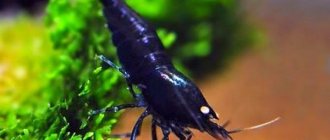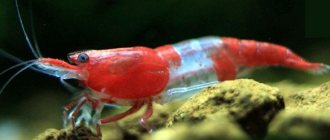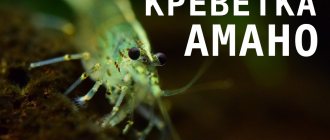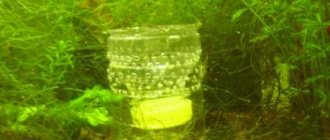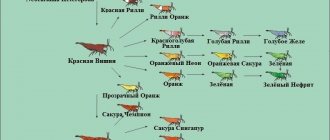Home › Sea (marine aquarium) ›
( 3 ratings, average: 5.00 out of 5)
The Pacific doctor shrimp or skunk (Lysmata amboinensis) is a very attractive looking, omnivorous and useful shrimp for the home marine aquarium with very interesting behavior. Also known as the Pacific cleaner shrimp and skunk cleaner shrimp. This shrimp is an excellent scavenger because most of its diet consists of parasites and dead fish tissue.
Description
Adult shrimp grow up to 5-6 cm. They have long white antennae, most shrimp have three pairs of them. The body and legs are pale amber in color with longitudinal white stripes. The central white stripe is surrounded by wide purplish-red stripes. The red tail has several symmetrical white spots. There are 10 pairs of legs, the front pair has tongs. There are a pair of protruding eyes, but the Doctor Shrimp is supposed to have poor eyesight: it can only see bright objects (other tropical shrimp and fish).
Antonbruun shrimp - false anemone
Simplicity of content:
Latin name: Urocaridella antonbruunii
Recommended aquarium volume: from 100 liters
Length: 3 cm.
Homeland: Indo-Pacific region
Average cost: 1000 rubles
In an aquarium, Antonbruuna is almost invisible due to its transparent body and small size. However, the maintenance requirements for false anemone are minimal.
- Water temperature 24 – 27°C;
They easily become food for large fish.
Maintenance and care
The doctor shrimp is a very interesting resident of the home marine aquarium, and also a very useful scavenger. Dip your hand into a home saltwater aquarium with these animals, and the doctor shrimp will immediately get to work: they will begin to clean your hand of dead cells. In addition, they will clean the aquarium from parasites, which often infect many species of tropical marine fish.
To keep a doctor shrimp, a home aquarium of any size is suitable, even a nano aquarium, with sea water and, preferably, with a reef.
When initially moving into a new aquarium, a drip acclimatization period is required. In addition, like all shrimp, the doctor shrimp does not tolerate copper content in water and high nitrate content. For good shedding, it requires the addition of iodine.
Water parameters:
Temperature : 22-26° C; Hardness dKH : 8-12; pH : 8.1-8.4; SG : 1.023-1.025.
Doctor shrimp (cleaner) Lysmata amboinensis
The doctor shrimp lives in the Indian and Pacific oceans; it is also quite often called the Pacific shrimp. This type of shrimp prefers to settle in pairs or small groups on corals.
Doctor shrimp (cleaner) Lysmata amboinensis
Thanks to its peaceful disposition, relative unpretentiousness and undoubted usefulness. The doctor shrimp is a very common resident in marine aquariums. Aquariums from 60 liters are suitable for keeping. These shrimp should not be kept in nano marine aquariums. We must try to provide them with as much volume as possible. Since in such conditions the behavior of cleaner shrimp will be more natural. It is good to keep shrimp together with fish such as zebrafish and white-breasted tang. Also, cleaner shrimp of this species gets along well with other invertebrates. Keeping with predatory fish species is not recommended because shrimp will become prey.
The cleaner shrimp feeds on almost all types of food. Used to feed the inhabitants of a marine aquarium. This can be frozen food, brine shrimp, shrimp, shellfish meat, dry food. Feeding with various vitamin complexes intended for feeding marine shrimp is also useful. They actively pick up food that has not been eaten by fish or that has fallen into rock crevices. The amount of food a shrimp receives affects the frequency of molting and, accordingly, its lifespan, which is also affected by the iodine content in seawater.
Doctor shrimp (cleaner) Lysmata amboinensis
Cleaner shrimp are active during the day and evening. At night, they usually rest in shelters among rocks. Shrimp grow from 5 to 7 centimeters. The lifespan, depending on the conditions of detention, is from 1 to 3 years. A normal shedding period is approximately once every 2 months. The Pacific doctor shrimp is considered an unpretentious inhabitant of the aquarium. However, as with keeping other marine life, they need to ensure proper water parameters.
Aquarium mates
In nature, the doctor shrimp Lysmata amboinensis lives in pairs, but in captivity it usually prefers to be alone. If shrimp are kept in a group and two of them form a pair, the pair becomes aggressive and can even kill other shrimp.
In nature, doctor shrimps are engaged in cleaning moray eels and other fish; in an aquarium they also need a “patient”. When doctor shrimp are ready to render their services, they gather on the reef in one place, performing a swaying motion that indicates that they are ready to be cleaned. Sea fish wishing to receive treatment swim up to the “doctors” themselves. Surgeon fish are especially in need of such cleaners. The shrimp themselves do not harm the crystals, polyps and other inhabitants of the reef.
Some fish (cottonfish, lionfish), as well as predatory shrimp and crabs, can eat the doctor shrimp.
Compatibility
The easy maintenance of shrimp and their help in cleansing the water space are not the only advantages of amano. They have a peaceful and accommodating disposition, their tiny claws are only suitable for eating thread-like algae, and they are absolutely safe for small fish. Often they are even kept with fry, but experts still advise not to take risks and separate fish fry from shrimp. But the amankas themselves can be eaten by large cichlids. And even small predators that are unable to absorb the shrimp simply tear it in half. Therefore, the compatibility of amankas with aggressive fish is unacceptable. These individuals get along best with ancistrus, gouramis, cockerels, tetras, otocinclus, and livebearers. There are cases when amankas coexist well with barbs, but still, the compatibility of these individuals is minimal. The shrimp will have to constantly hide, and their life will be full of stress.
The compatibility of amano with other types of shrimp is optimal. The exception is Mahrobrachiums. Also unfavorable is the proximity of amankas to cherry shrimp and crystals.
Return to content
Fish
It is the fish that are expected to be most effective in cleaning the aquarium. In addition, fish are still the main inhabitants of most aquariums.
Poeciliaceae
These viviparous fish eat algae quite well, especially softer ones, like filamentous algae. Those who have observed guppies, swordtails and mollies have noticed that their lower jaw works like a scraper. However, it is worth saying honestly: livebearers are unable to clear the aquarium of fouling even in large quantities.
Swordtails
Mollies
Guppy
It is not advisable to keep fish on a starvation diet to encourage them to eat algae. Therefore, the task of cleaning poeciliids is to help other cleaners in complex biological care.
Brocade Pterygoplichthus
The luxurious chain-mail catfish opens the list of vertebrate cleaners. With a large aquarium, it can grow up to 30–40 cm in length. With such a size, even large predatory cichlids are not afraid of him. But the best thing is that the mouth opening, equipped with horny plates, forms a dense sucker.
No algal fouling can withstand such a tool. The omnivorous nature of pterygoplicht allows it to be fed any live frozen food that sinks to the bottom, as well as scalded lettuce, spinach, and zucchini.
True, it is hardly worth putting small and slow fish in an aquarium with it - they can be eaten inadvertently, without malicious intent.
Ancistrus
Another representative of the chain-mailed catfish with a sucker, only this time much smaller in size. Its appearance is very original and serves partly as protection, partly as camouflage - it is not easy to notice a motionless catfish in a small layer of silt.
When it comes to cleaning the aquarium from fouling, they are not in first place, but they win due to other factors: their peaceful nature and appearance.
Siamese algae eater
One of the most effective cleaners from the carp family. A couple of algae eaters in a hundred-liter aquarium can rid it of all unwanted types of algae, including black beard.
At a young age, algae eaters eat unwanted flora very actively, but with age this ability is gradually lost: partly this is due to the laziness of adult fish, partly with getting used to more nutritious and accessible aquarium food.
Feeding
Amanks feed not only on algae. Their nutrition must be complete, since they are quite large individuals. Cutting off the shrimp's diet in order to encourage them to clean the aquarium even more is cruel and short-sighted. Amano shrimp may become sick and have a shortened lifespan due to malnutrition. A balanced diet for this species includes: fish and shrimp food, detritus, cucumber, zucchini, blanched spinach, seaweed wafers. Shrimp will also happily eat bloodworms, tubifex, frozen food and small worms.
During the molting period, the amano's diet should be supplemented with foods high in cellulose. It is this ingredient that shrimp need to restore their shell. But it is not recommended to constantly feed these individuals with such food. Otherwise, they will stop eating algae altogether.
Return to content
What are cleaners for?
During the life of hydrobionts, large amounts of nitrogen compounds are released into the water. Combined with high water temperatures and bright lighting (especially if the aquarium is exposed to direct sunlight), they create a favorable environment for algae growth.
Algae enter an artificial reservoir in various ways: with feed, new plants and aquatic organisms, soil, decorations, equipment and water. If there are favorable conditions for existence in the aquarium, algae begin to actively reproduce, covering the glass, soil, decorations and plants with a continuous coating. As a result, plant growth is inhibited, the appearance of the reservoir deteriorates, and water quality decreases, which can lead to illness in aquatic organisms.
The aquarium orderlies - cleaner fish - will help clean the tank from algae. For them, algae serves as their main food.
For us, work is a way of life for them.
Aquarium cleaners, of course, do not clean out of request or out of a sense of duty. They are simply reproducing thousands of years of behavior shaped by natural selection.
- Herbivorous organisms participate in eating algae - in nature they also clean water spaces, it’s just that the volume of a natural pond or river is so large that this work remains unnoticeable.
- Sometimes an aquarist may also need predators - to get rid of some unwanted inhabitants, which are troublesome and not completely safe to remove by chemical means or physical removal.
All animal helpers can be classified into three different groups: molluscs, fish and arthropods.

